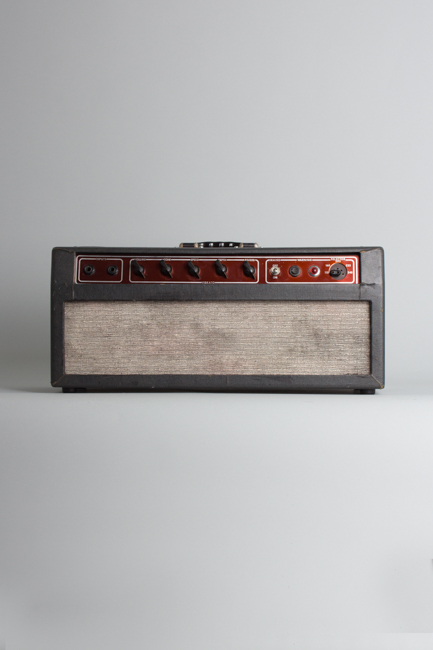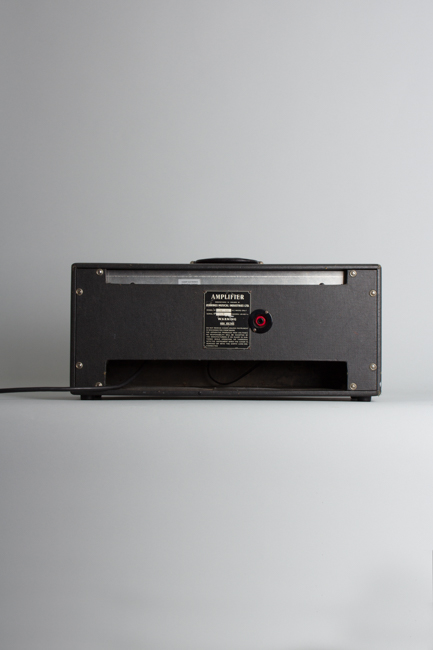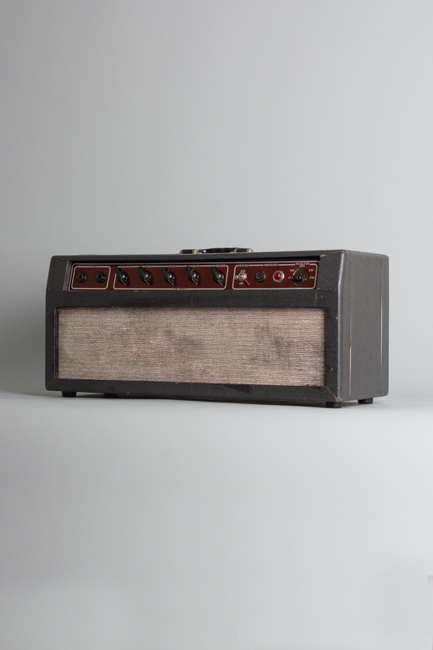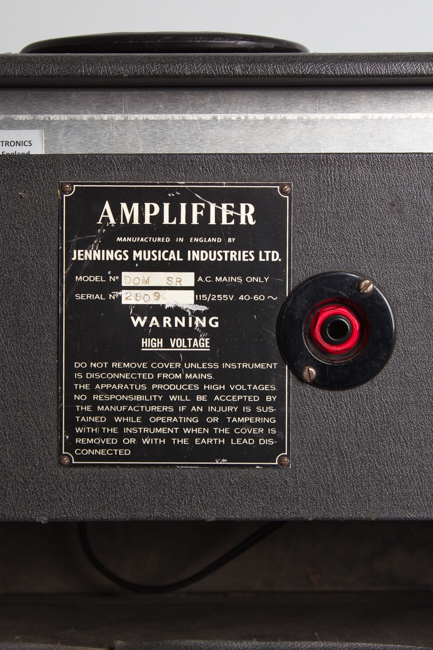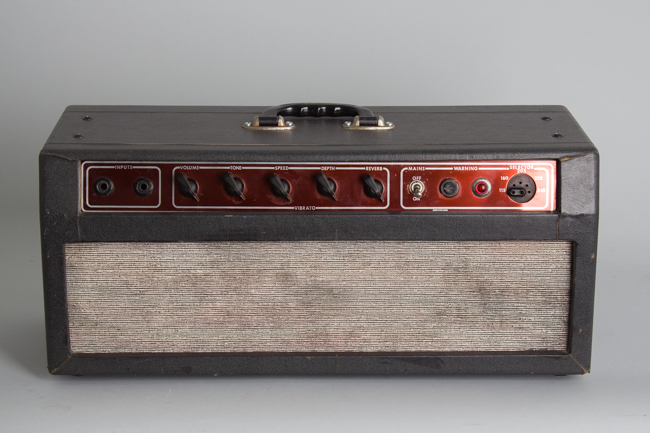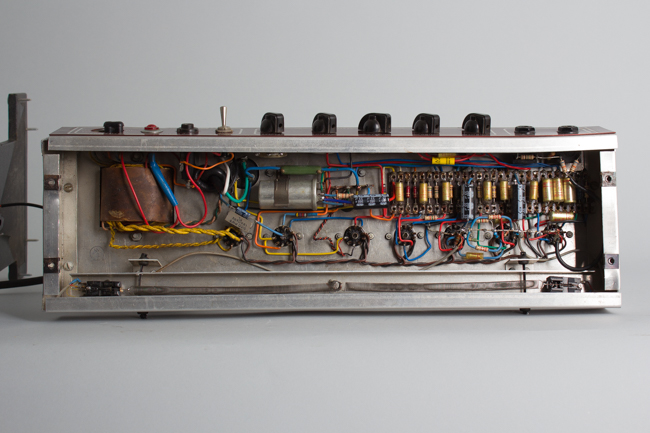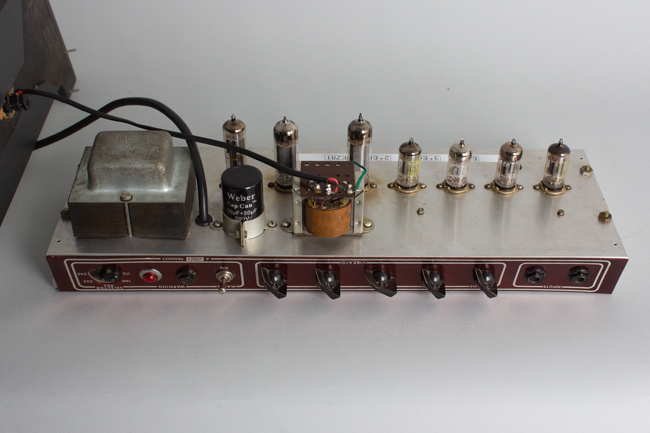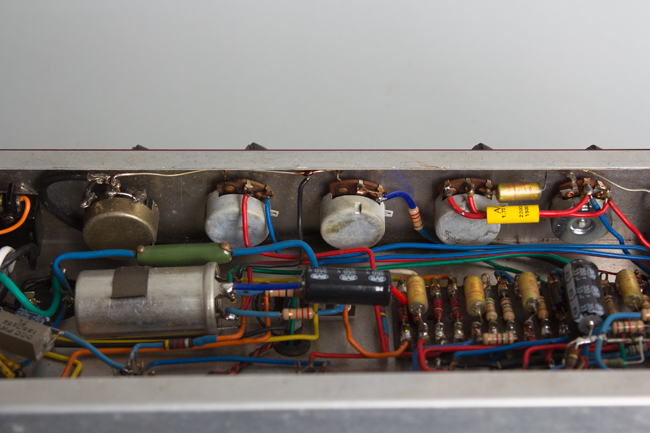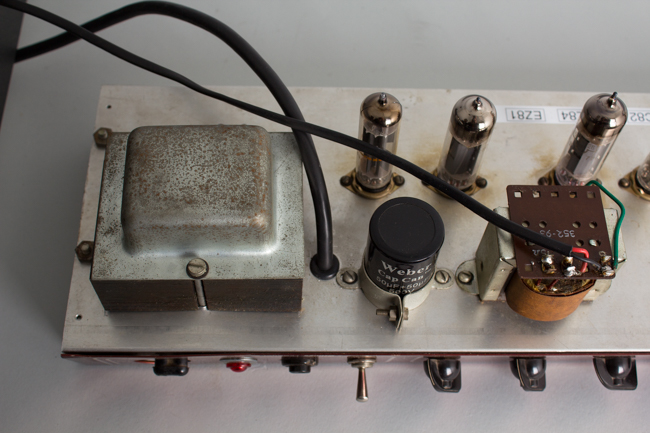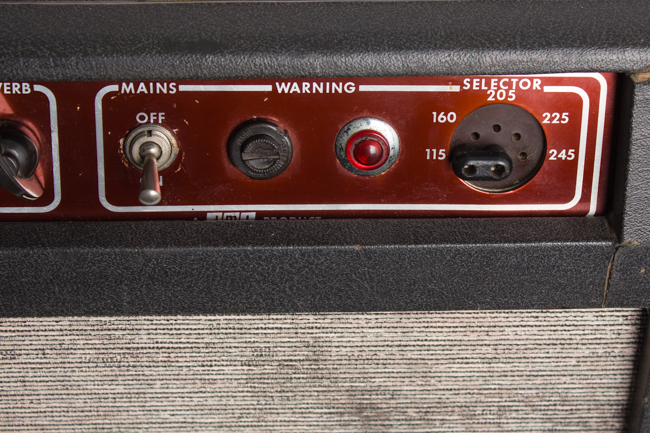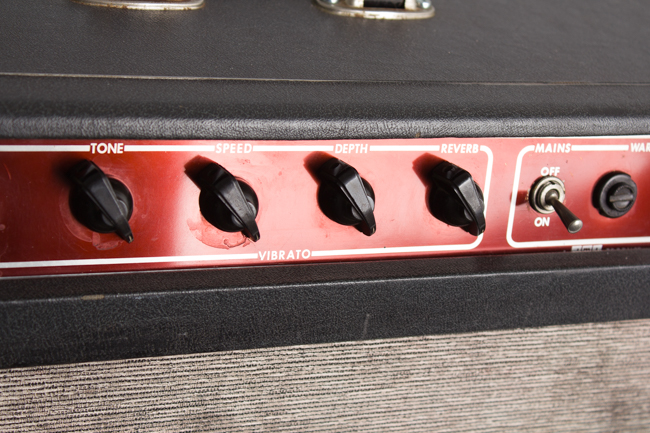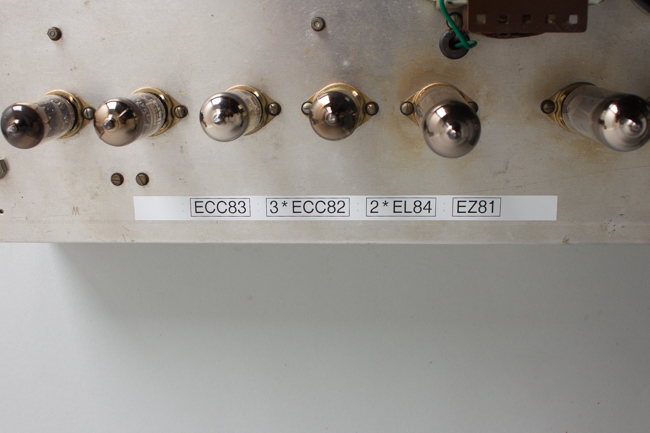Domino DOM-SR Head Tube Amplifier, made by JMI/Vox (1964)
This item has been sold.
Item # 12186
Prices subject to change without notice.
Domino DOM-SR Head Model Tube Amplifier, made by JMI/Vox (1964), made in Dartford, Kent, England, black Rexine finish.
This is a generally nicely preserved Domino Super Reverb amp head, made by JMI/Vox in the mid-sixties. JMI's "Domino" series of guitar and bass amplifiers were intended as entry level products. Introduced in 1963, compared to the professionally priced Vox brand they were targeted toward students, beginners or semi-pros on a budget. While this series of amplifiers lacked some of the sophisticated appearance of their Vox counterparts, JMI often incorporated a simplified version of familiar Vox circuits in their Domino designs.
Described as "a very fine super-grade amplifier in two sections" in the 1963 Jennings catalog, this particular amp can be likened closest to the Vox AC-10SRT head, also offered as a 'piggyback' format around the same time. It features a single channel with two inputs and controls for volume and tone as well as tremolo intensity, speed and reverb level. Like the Vox AC-10, the Domino Super Reverb was powered by two EL84 power tubes in a Class A, cathode biased, yielding around 10-15 watts of power into the intended 2x10" complimentary cabinet.
This amp also used the infamous crystal phono cartridge-based reverb tank, specially designed by Vox to avoid paying the $1-per-amp licensing fee to use a Hammond-Accutronics tank. This tank worked to a degree, but the tone and depth of the reverb was certainly lacking when compared to Fender amps of this era. Furthermore, the phono cartridge-based design was temperamental and would easily slip into a howling acoustic feedback if the amp was played too loudly.
Apart from this quirk the DOM-SR is a fairly rare (especially here in the US) and fantastic sounding low-wattage head-and-cab amplifier. This is basically an AC-10 Super Reverb Twin (which many consider to be one of the greatest amps of all time) in a head format, allowing easy multiple speaker choices -- perfect for the studio!
Height is 9 in. (22.9 cm.), 21 1/4 in. (54 cm.) width, and 8 in. (20.3 cm.) in depth at deepest point.
Cosmetically, this little Domino head is in very good shape. The black Rexine covering shows some moderate wear, mostly around seams and edges. The grille cloth shows some minor staining/off-coloring and the 'Domino' logo is sadly no longer present. The red/copper control plate shows typical scuffing, most notably around the power switch and tone and speed controls, but otherwise is in nice shape. The handle and overall hardware remain all original.
Electrically, this little amp head is nicely original; both the power and output transformer appear to be original, or at least period. The volume and reverb controls appear to have been replaced. The reverb 'tank' is original and works about as well as one can expect this design to work; its intensity/volume is fairly inconsistent and the reverb is highly sensitive to any vibration or movement -- ideal more for a controlled environment like the studio, less reliable in a live setting. Otherwise, the amp has seen our typical maintenance and servicing, including replacement of electrolytic capacitors, a 3-prong grounded power cord, all sockets, pots and jacks cleaned and power tubes biased to spec.
A fairly rare and quite frankly a sleeper studio secret for a fraction of the value of the revered AC-10 SRT. Very Good + Condition.
This is a generally nicely preserved Domino Super Reverb amp head, made by JMI/Vox in the mid-sixties. JMI's "Domino" series of guitar and bass amplifiers were intended as entry level products. Introduced in 1963, compared to the professionally priced Vox brand they were targeted toward students, beginners or semi-pros on a budget. While this series of amplifiers lacked some of the sophisticated appearance of their Vox counterparts, JMI often incorporated a simplified version of familiar Vox circuits in their Domino designs.
Described as "a very fine super-grade amplifier in two sections" in the 1963 Jennings catalog, this particular amp can be likened closest to the Vox AC-10SRT head, also offered as a 'piggyback' format around the same time. It features a single channel with two inputs and controls for volume and tone as well as tremolo intensity, speed and reverb level. Like the Vox AC-10, the Domino Super Reverb was powered by two EL84 power tubes in a Class A, cathode biased, yielding around 10-15 watts of power into the intended 2x10" complimentary cabinet.
This amp also used the infamous crystal phono cartridge-based reverb tank, specially designed by Vox to avoid paying the $1-per-amp licensing fee to use a Hammond-Accutronics tank. This tank worked to a degree, but the tone and depth of the reverb was certainly lacking when compared to Fender amps of this era. Furthermore, the phono cartridge-based design was temperamental and would easily slip into a howling acoustic feedback if the amp was played too loudly.
Apart from this quirk the DOM-SR is a fairly rare (especially here in the US) and fantastic sounding low-wattage head-and-cab amplifier. This is basically an AC-10 Super Reverb Twin (which many consider to be one of the greatest amps of all time) in a head format, allowing easy multiple speaker choices -- perfect for the studio!
Height is 9 in. (22.9 cm.), 21 1/4 in. (54 cm.) width, and 8 in. (20.3 cm.) in depth at deepest point.
Cosmetically, this little Domino head is in very good shape. The black Rexine covering shows some moderate wear, mostly around seams and edges. The grille cloth shows some minor staining/off-coloring and the 'Domino' logo is sadly no longer present. The red/copper control plate shows typical scuffing, most notably around the power switch and tone and speed controls, but otherwise is in nice shape. The handle and overall hardware remain all original.
Electrically, this little amp head is nicely original; both the power and output transformer appear to be original, or at least period. The volume and reverb controls appear to have been replaced. The reverb 'tank' is original and works about as well as one can expect this design to work; its intensity/volume is fairly inconsistent and the reverb is highly sensitive to any vibration or movement -- ideal more for a controlled environment like the studio, less reliable in a live setting. Otherwise, the amp has seen our typical maintenance and servicing, including replacement of electrolytic capacitors, a 3-prong grounded power cord, all sockets, pots and jacks cleaned and power tubes biased to spec.
A fairly rare and quite frankly a sleeper studio secret for a fraction of the value of the revered AC-10 SRT. Very Good + Condition.
